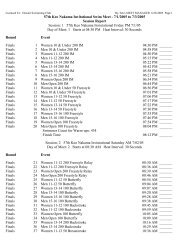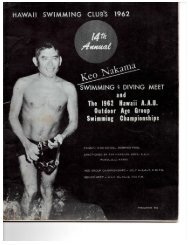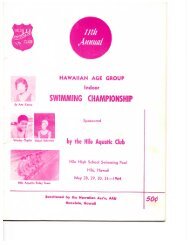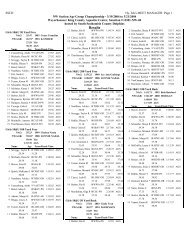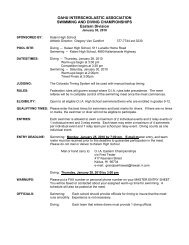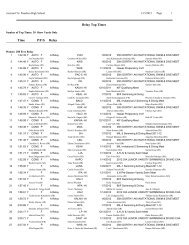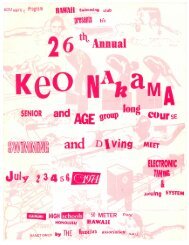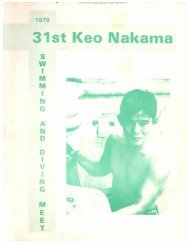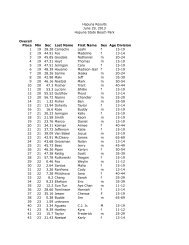2010 Keo Nakama Invitational - Hawaii Swimming
2010 Keo Nakama Invitational - Hawaii Swimming
2010 Keo Nakama Invitational - Hawaii Swimming
Create successful ePaper yourself
Turn your PDF publications into a flip-book with our unique Google optimized e-Paper software.
The Molokai Channel<br />
By Lin Clark<br />
HSN Assistant Editor<br />
All <strong>Hawaii</strong> is proud of you, <strong>Keo</strong> <strong>Nakama</strong>.<br />
You and your spirit and your strength have given us all a thrill<br />
that goes far beyond the automatic burst of pride in a victor.<br />
You have reminded us all what man can do if he has a mind to.<br />
Sometimes in these dark days of world danger when awesome<br />
forces threaten, we tend to forget what a man is, how he is, what<br />
he can do. You have refreshed our memory.<br />
Your triumph over the Molokai Channel is our triumph, too.<br />
Thank you for that, <strong>Keo</strong> <strong>Nakama</strong>. We all needed it.<br />
……So read a note of appreciation which appeared in the Monday, Oct. 2, 1961<br />
editorial section of the Honolulu Advertiser.<br />
From 1930, <strong>Keo</strong> <strong>Nakama</strong> was a 41-year-old physical education instructor at<br />
William Paul Jarrett Inter ate School. The 5-6, 145 pound swimmer hadn’t competed<br />
since winning 13 National AAU championships between 1939-45.<br />
What drew over 10,000 spectators and well-wishers to the beach and cliffs<br />
surrounding Hanauma Bay on Friday evening, Sept. 29, 1961 was history in the<br />
making. <strong>Nakama</strong> had tackled the 27-mile Kaiwi (Molokai) Channel and would<br />
emerge from the water 15 hours and 37 seconds after diving in near Laau Point<br />
on Molokai.<br />
But what awed the entire state of <strong>Hawaii</strong> was something more. It was that something<br />
<strong>Nakama</strong> tried to instill in the Island youngsters he came in contact with<br />
as a teacher, swim coach and softball coach. That even those goals which<br />
seemed in able can be achieved through the proper dedication, preparation and<br />
effort. Kiyoshi (later “<strong>Keo</strong>”) “Casey” <strong>Nakama</strong> began his legendary swimming<br />
career in the <strong>Hawaii</strong>an.<br />
Commercial & Sugar Company irrigation ditches in Puunene, Maui under the<br />
tutelage of Hall of Famer coach Soichi Sakamoto. Sakamoto had started with a<br />
small group of youngsters – including <strong>Nakama</strong>’s sprint running-mate Takashi<br />
(Halo) Hirose – which grew to over 100 boys and girls.<br />
The plantation allowed Sakamoto to move his entourage to the new Frank F.<br />
Baldwin Memorial Park Pool where, in 1937, “The Maui 3-Y.S.C.” (Three-<br />
Year <strong>Swimming</strong> Club) was born. From 1930 -1941 the 3-Y.S.C.s won three<br />
AAU men’s outdoor teams championships, but their real goal was the 1940<br />
Olympics.<br />
Both <strong>Nakama</strong> and Hirose went on<br />
to win several individual and team<br />
honors under Ohio State University<br />
Coach Mike Peppe, during WWII,<br />
But it is believed that the war and<br />
subsequent cancellation of the ’40<br />
Olympics was the only factor that<br />
kept them from winning Olympic<br />
swimming medals.<br />
In 1943 the Buckeyes were greeted<br />
by jeers and snide remarks at the National<br />
Indoor Championships at Yale<br />
University for entering a certain fresh<br />
man of Japanese ancestry. We were at<br />
war with Japan. Coach Peppe stood<br />
up and told the crowd that Ohio State<br />
has only Americans on this team and<br />
our American-Japanese boy swims.<br />
The crowd cheered the favored Yale<br />
swimmer, Renee Choteau, when he<br />
stood up on his block. When little<br />
<strong>Nakama</strong> took his place the crowd was<br />
deafeningly silent.<br />
Choteau caught <strong>Nakama</strong> at the 350<br />
mark of that 400, but <strong>Nakama</strong> – not<br />
to be denied–pulled ahead in the last<br />
five yards to win the event. The<br />
crowd, realizing here was a man<br />
worth of his Japanese-American title,<br />
gave <strong>Nakama</strong> a standing ovation.<br />
<strong>Nakama</strong> had shown a lot of people<br />
that day that anyone – even the Oriental<br />
son of an immigrant plantation<br />
worker – can become anyone he<br />
wants to,provided he is willing to<br />
work hard at it and be proud of what<br />
he is.<br />
It’s a philosophy <strong>Nakama</strong> has carried<br />
with him wherever he has ventured.






